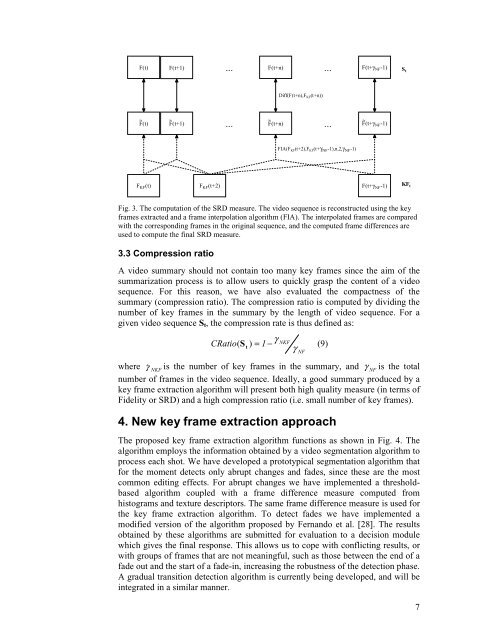an innovative algorithm for key frame extraction in video ...
an innovative algorithm for key frame extraction in video ...
an innovative algorithm for key frame extraction in video ...
You also want an ePaper? Increase the reach of your titles
YUMPU automatically turns print PDFs into web optimized ePapers that Google loves.
... ... S tF(t) F(t+1)F(t+n) F(t+γ NF -1)Diff(F(t+n),F KF (t+n))~ ~~ ~F(t) F(t+1)F(t+n) F(t+γ NF -1)... ...FIA(F KF (t+2),F KF (t+γ NF -1),n,2,γ NF -1)F KF (t) F KF (t+2) F(t+γ NF -1)KF tFig. 3. The computation of the SRD measure. The <strong>video</strong> sequence is reconstructed us<strong>in</strong>g the <strong>key</strong><strong>frame</strong>s extracted <strong>an</strong>d a <strong>frame</strong> <strong>in</strong>terpolation <strong>algorithm</strong> (FIA). The <strong>in</strong>terpolated <strong>frame</strong>s are comparedwith the correspond<strong>in</strong>g <strong>frame</strong>s <strong>in</strong> the orig<strong>in</strong>al sequence, <strong>an</strong>d the computed <strong>frame</strong> differences areused to compute the f<strong>in</strong>al SRD measure.3.3 Compression ratioA <strong>video</strong> summary should not conta<strong>in</strong> too m<strong>an</strong>y <strong>key</strong> <strong>frame</strong>s s<strong>in</strong>ce the aim of thesummarization process is to allow users to quickly grasp the content of a <strong>video</strong>sequence. For this reason, we have also evaluated the compactness of thesummary (compression ratio). The compression ratio is computed by divid<strong>in</strong>g thenumber of <strong>key</strong> <strong>frame</strong>s <strong>in</strong> the summary by the length of <strong>video</strong> sequence. For agiven <strong>video</strong> sequence S t , the compression rate is thus def<strong>in</strong>ed as:CRatioγ( S ) = 1 −NKFt(9)γNFwhere γNKFis the number of <strong>key</strong> <strong>frame</strong>s <strong>in</strong> the summary, <strong>an</strong>d γNFis the totalnumber of <strong>frame</strong>s <strong>in</strong> the <strong>video</strong> sequence. Ideally, a good summary produced by a<strong>key</strong> <strong>frame</strong> <strong>extraction</strong> <strong>algorithm</strong> will present both high quality measure (<strong>in</strong> terms ofFidelity or SRD) <strong>an</strong>d a high compression ratio (i.e. small number of <strong>key</strong> <strong>frame</strong>s).4. New <strong>key</strong> <strong>frame</strong> <strong>extraction</strong> approachThe proposed <strong>key</strong> <strong>frame</strong> <strong>extraction</strong> <strong>algorithm</strong> functions as shown <strong>in</strong> Fig. 4. The<strong>algorithm</strong> employs the <strong>in</strong><strong>for</strong>mation obta<strong>in</strong>ed by a <strong>video</strong> segmentation <strong>algorithm</strong> toprocess each shot. We have developed a prototypical segmentation <strong>algorithm</strong> that<strong>for</strong> the moment detects only abrupt ch<strong>an</strong>ges <strong>an</strong>d fades, s<strong>in</strong>ce these are the mostcommon edit<strong>in</strong>g effects. For abrupt ch<strong>an</strong>ges we have implemented a thresholdbased<strong>algorithm</strong> coupled with a <strong>frame</strong> difference measure computed fromhistograms <strong>an</strong>d texture descriptors. The same <strong>frame</strong> difference measure is used <strong>for</strong>the <strong>key</strong> <strong>frame</strong> <strong>extraction</strong> <strong>algorithm</strong>. To detect fades we have implemented amodified version of the <strong>algorithm</strong> proposed by Fern<strong>an</strong>do et al. [28]. The resultsobta<strong>in</strong>ed by these <strong>algorithm</strong>s are submitted <strong>for</strong> evaluation to a decision modulewhich gives the f<strong>in</strong>al response. This allows us to cope with conflict<strong>in</strong>g results, orwith groups of <strong>frame</strong>s that are not me<strong>an</strong><strong>in</strong>gful, such as those between the end of afade out <strong>an</strong>d the start of a fade-<strong>in</strong>, <strong>in</strong>creas<strong>in</strong>g the robustness of the detection phase.A gradual tr<strong>an</strong>sition detection <strong>algorithm</strong> is currently be<strong>in</strong>g developed, <strong>an</strong>d will be<strong>in</strong>tegrated <strong>in</strong> a similar m<strong>an</strong>ner.7
















